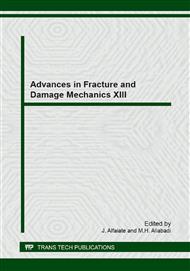p.201
p.205
p.209
p.213
p.217
p.221
p.225
p.229
p.233
Localization of Barely Visible Impact Damage (BVID) in Composite Plates
Abstract:
This paper exploits the implementation of a delay-and-sum imaging method using Lamb wave signals to localise barely visible impact damage (BVID) in quasi-isotropic composite panels. The structural discontinuities, such as opening and stiffener, has also been tested to reflect the common structural features of an aircraft and to examine the feasibility of the proposed detection technique. The prediction results are compared with ultrasonic C-scan images, which indicate location error for three different panels –flat panel, flat panel with an opening and stiffened panel. The accuracy is believed to be improved by increasing the number of transducers. Overall the proposed damage detection technique, with the use of only four transducers, demonstrated sufficient accuracy and efficiency in impact damage detection and can be applied alongside the traditional NDT inspections for providing a priori information of the impact damage location.
Info:
Periodical:
Pages:
217-220
Citation:
Online since:
September 2014
Authors:
Price:
Сopyright:
© 2015 Trans Tech Publications Ltd. All Rights Reserved
Share:
Citation:


